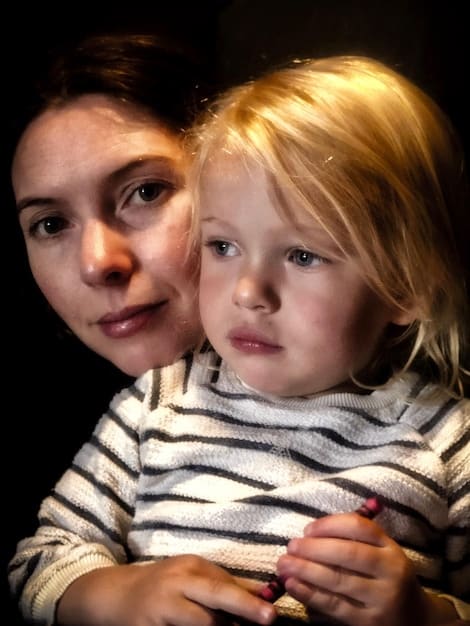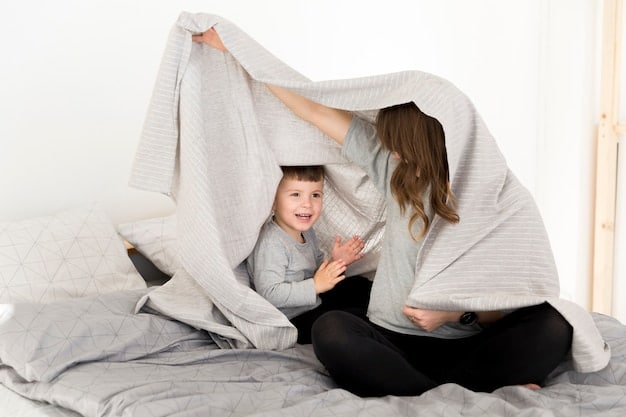Managing Separation Anxiety: Tips for Easing Your Baby’s Distress

Managing separation anxiety in babies involves creating a secure and predictable environment, using gradual exposure techniques, and offering comfort and reassurance to help your little one feel safe when you’re not around.
Navigating the emotional milestones of infancy can be challenging, especially when managing separation anxiety: tips for easing your baby’s distress are essential for both your peace of mind and your baby’s well-being.
Understanding Separation Anxiety in Babies
Separation anxiety is a normal developmental stage that most babies experience. It typically emerges around 6 to 9 months of age and can last until the child is about 2 years old. Knowing what causes this anxiety can help you better support your baby.
What Causes Separation Anxiety?
Separation anxiety arises from a baby’s growing understanding of object permanence. They realize that when a parent or caregiver leaves, they still exist, but the baby doesn’t know when they will return. This uncertainty can cause significant distress.
Common Triggers
Certain situations can trigger separation anxiety more than others. These may include leaving your baby at daycare, bedtime, or even stepping away momentarily at home. Recognizing these triggers can help you prepare and ease the transition for your baby.
- 👋 Leaving for daycare or work
- 🌙 Bedtime routines
- 🚶 Stepping out of sight at home
- 🏥 Doctor’s visits
Understanding these triggers and the underlying causes of separation anxiety can make it easier to implement strategies that provide comfort and security for your baby. It’s a phase, and with patience and the right approach, you can help your baby navigate it successfully. This understanding forms the base for effectively managing and alleviating their distress.

Creating a Secure Environment
A secure environment is essential for helping your baby manage separation anxiety. A sense of safety and stability can significantly reduce their distress when you need to be apart. Here are some ways to create that environment.
Establish a Routine
Babies thrive on routine. Predictable schedules help them feel secure because they know what to expect. Consistent routines around feeding, naps, and bedtime can minimize anxiety by providing a sense of order and control.
Safe and Familiar Surroundings
Ensure that your baby spends time in a safe and familiar space, whether it’s their crib, a playpen, or a specific area in the house. Having a consistent, secure location helps them feel more comfortable even when you’re not directly present.
- 🧸 Keeping familiar toys and blankets nearby
- 🎶 Playing the same soothing music
- 🖼️ Displaying family photos
- 🛌 Ensuring a consistent sleep environment
By creating a secure and predictable environment, you provide a stable foundation for your baby. These measures reassure them that their needs will be met and that they are safe, even when you’re not physically close. This, in turn, helps reduce separation anxiety and promotes overall emotional well-being.
The Power of Gradual Exposure
Gradual exposure involves slowly increasing the amount of time your baby spends away from you. This technique helps them adjust to separation and builds their confidence in their ability to cope. It’s a gentle way to reduce anxiety over time.
Start with Short Separations
Begin with very brief periods of separation, such as leaving the room for a few minutes while your baby is engaged in an activity. Gradually increase the duration as your baby becomes more comfortable. This controlled approach minimizes distress.
Practice “Peek-a-Boo” and Similar Games
Games like “peek-a-boo” teach your baby that even when you disappear, you come back. These games reinforce the idea that separation is temporary. The playful nature of the game also makes the learning experience enjoyable.
- ⏰ Starting with 5-10 minute separations
- 🏠 Leaving the room while baby plays, then returning
- 🤗 Celebrating successful short separations with praise
- 👋 Practicing short separations with other caregivers
Gradual exposure, combined with playful interactions, helps your baby build resilience and confidence. By slowly increasing the duration of separations, you give them the opportunity to adapt and learn that you always return. This approach reduces the intensity of separation anxiety and strengthens the bond between you and your baby. Regular implementation of these practices can lead to significant improvements in your baby’s emotional well-being.

Effective Comforting Techniques
When your baby experiences separation anxiety, providing immediate comfort is crucial. Quick and effective responses can reassure them and reduce the intensity of their distress. There are several techniques you can use to offer comfort.
Offer Physical Reassurance
Hugging, cuddling, and gentle touch can be incredibly soothing. Physical contact releases endorphins that help calm your baby. Make sure your touch is gentle and comforting, showing them that you’re there to protect and care for them.
Use Soothing Words and Tone
Speak to your baby in a calm and reassuring voice. Tell them that you are there for them and that they are safe. The tone of your voice matters just as much as the words you use. A gentle, loving tone can ease their anxiety.
- 🗣️ Repeating soothing phrases like “Mommy/Daddy will be back soon”
- 🎶 Singing a calming song
- 🫂 Holding them close and rocking gently
- 🌼 Using a pacifier or comfort object
Effective comforting techniques provide immediate relief to your baby during episodes of separation anxiety. By offering physical reassurance and using soothing words, you create a sense of security and trust. These responses help your baby regulate their emotions, reinforcing the idea that you are a reliable source of comfort. Consistent application of these techniques builds their confidence and reduces the long-term impact of separation anxiety.
The Role of Positive Reinforcement
Positive reinforcement can play a significant role in helping your baby overcome separation anxiety. By rewarding their bravery and positive adjustments, you encourage them to feel more confident and secure. This approach focuses on building their self-esteem and resilience.
Praise and Encouragement
When your baby handles separation well, offer sincere praise and encouragement. Acknowledge their bravery and let them know how proud you are of them. Positive verbal reinforcement can boost their confidence and encourage them to repeat the behavior.
Small Rewards and Affection
Offer small rewards or additional affection to reinforce positive behavior. This could be extra playtime, a favorite snack, or simply more cuddles. These rewards create a positive association with being independent for short periods.
- 👏 Clapping and cheering when they play happily alone
- 🎁 Offering a small, special toy after a successful separation
- ✨ Giving extra cuddles and kisses when they’re brave
- 🥰 Praising their ability to play independently.
Positive reinforcement is an effective strategy for building your baby’s confidence and reducing separation anxiety. By recognizing and rewarding their brave behavior, you help them associate separation with positive experiences. This, in turn, makes it easier for them to manage their anxiety and promotes a sense of independence and security. Consistent application of these techniques can significantly improve their emotional well-being and resilience.
When to Seek Professional Help
While separation anxiety is a normal developmental stage, there are times when it may require professional attention. Recognizing the signs that your baby needs extra support can ensure they receive the appropriate care. Understanding when to seek help can make a significant difference in their overall well-being.
Signs of Severe Anxiety
Look out for signs of severe anxiety, such as persistent distress, excessive crying, or difficulty sleeping. If your baby’s anxiety is interfering with their daily activities or your ability to care for them, it’s time to seek professional advice. Early intervention can prevent the anxiety from worsening.
Consulting a Pediatrician or Therapist
If you’re concerned about your baby’s separation anxiety, consult with a pediatrician or child therapist. They can provide an assessment and recommend appropriate strategies, such as behavioral therapy or parental guidance. Seeking professional help demonstrates your commitment to your baby’s well-being.
- 🩺 Scheduling a visit with the pediatrician
- 🤝 Seeking guidance from a child therapist
- 📚 Joining a parenting support group
- 📱 Utilizing online resources for parents
Knowing when to seek professional help ensures that your baby receives the necessary support to manage their separation anxiety effectively. Recognizing the signs of severe anxiety and consulting with healthcare professionals can provide you with the tools and strategies needed to help your baby thrive. Early intervention can make a significant positive impact on their emotional and developmental health.
| Key Point | Brief Description |
|---|---|
| 🧸 Routine & Safety | Establish consistent routines and ensure a safe environment to reduce anxiety triggering. |
| 👋 Gradual Separation | Start with short separations and gradually increase the time apart to build confidence. |
| 🫂 Comforting Techniques | Offer physical reassurance and use soothing words to provide immediate comfort. |
| ✨ Positive Reinforcement | Praise and reward brave behavior to encourage independence and reduce anxiety. |
Frequently Asked Questions
▼
Separation anxiety usually begins around 6 to 9 months of age, as babies start to understand object permanence and feel anxious when their caregivers are not present.
▼
Separation anxiety can last until the child is about 2 years old, but it varies for each child. Consistent routines and comfort can help ease the duration and intensity.
▼
Common signs include crying when you leave, clinging to you, resisting going to daycare, and difficulty sleeping alone. Recognizing these signs helps in addressing the anxiety.
▼
Establish a quick goodbye routine, provide a comfort item, and communicate with the daycare staff to ensure your baby feels safe. Avoid lingering, as it can increase anxiety.
▼
Seek professional help if the anxiety is severe, persistent, and interferes with your baby’s daily activities or your ability to care for them. Early intervention can improve outcomes.
Conclusion
Managing separation anxiety in babies is a journey that requires patience, understanding, and consistent application of proven techniques. By creating a secure environment, using gradual exposure, offering comfort, and seeking professional help when needed, you can effectively ease your baby’s distress and promote their emotional well-being, ensuring they grow into confident and secure individuals.





